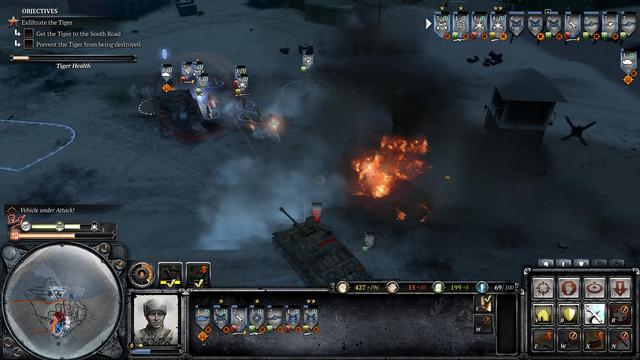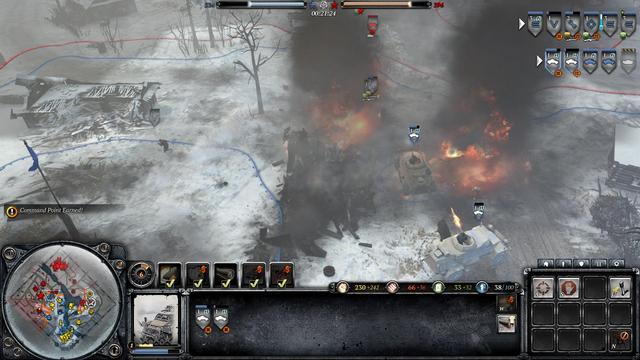All Quiet on the Eastern Front.
More than a few folks call the original Company of Heroes the greatest RTS of all time. There are a few others who'd scoff at such a statement, but I'd bet dollars to doughnuts they didn't play it—if nothing else, it belongs in the conversation. I was playing it on and off all the way through the night before I went to preview its sequel, Company of Heroes 2, for the first time, so you might say I'm a fan. And as one, I'm both excited and slightly deflated by what Relic has accomplished this time out.
Company of Heroes 2's biggest successes and failures both rest upon its commitment to replicating the excellence of its predecessor faithfully, almost too much so. Don't get me wrong, there's a new game here—a great one at that—but while its new concepts and features mostly represent steps in the right direction, they're still small steps; ones that don't quite reflect the seven years that have passed since the original lit a fire under the genre's collective ass.
CoH2's opening salvo is a 14-mission campaign that tells the tale of World War II's Eastern front from the perspective of the embattled Soviet Union. It takes some serious narrative barrel-rolling to garner any emotional investment out of a war between two of history's greatest military powers, but Relic manages as well as can be imagined by hinging it all on the grit, determination, and sacrifice of the millions of brave Russian soldiers whose blood ultimately paid for the Allied victory wholesale. Scripted events and in-engine storytelling were a strong point of the original, and the same holds true here.
The chaos of war is all too real at moments, with the relentless cacophony of artillery barrages assaulting your ears as you watch scads of Russian conscripts get chopped mercilessly down by MG fire. Excellent animations and an absolutely killer sound package come together beautifully to make the more pitched missions feel overwhelming during their climaxes. It's just a shame that the cutscenes filling in the blanks between sorties fall so short of the bar set by the campaign's best moments. The over-saturated color schemes of the character's uniforms clash terribly with the muted battlefields they stand upon, and their clumsy animations soundly defeat all my attempts to become immersed in the tale being told. In battle, Company of Heroes 2 is the genuine article, but off the field, it feels more like a cheap imitation.
But if that sounds harsh, it's only because the gameplay side of the lengthy campaign is so well executed that the story's presentation is so disappointing. The Eastern Front was bloody, bloody business indeed, and even when I “succeeded” in my missions it was hard to stave off the feeling that I had actually lost. Heck, the first three missions essentially have you throwing conscripted corpses-to-be to their deaths by the truckload just to stave off capture or total defeat. You know you're in for a grim ride when you're being tasked to destroy your own buildings and equipment while setting fire to your own fields, burning friend and foe alive at once. The variety is impressive too, showcasing the many moving parts, both old and new, that give the franchise the depth for which it's known.
However, the best place for all those pieces to come together is still the multiplayer skirmishes. This is where all the tweaks and additions show their true value, and while no one thing stands out too much, the sum of all the changes is notable. Possibly the least talked about, but most impactful difference, is in how resource points are handled. Infantry units are no longer tied up at the center of the territory they're capturing. Instead, simply being physically present within the capture radius suffices, allowing for real firefights to be fought while grabbing new territory.

Additionally, you can build ammo or fuel depots on pretty much any capture point, granting you more direct control of your economy. You can stack fuel to tech up and focus on vehicles, or hoard munitions to buy upgrades and call in off-map support more often. Since you no longer need to fight over specific resource points to facilitate your strategy of choice, you'll find that battles take up a lot more of the map than in CoH1, where fighting always broke out over the same vital sectors.
This kind of refinement typifies the Company of Heroes 2 experience. Line of sight is now simulated realistically, making indirect fire weapons and guerrilla tactics credible threats. Incendiary weapons now spread fire as they would in real-life, giving things like molotov cocktails the ability to slowly destroy buildings and even entire patches of forest over time, dynamically changing the face of the battlefield. Aside from just dropping support weapons when killed, infantry have a chance to drop purchased upgrades like DP-28s or panzerschrecks, making the prospect of losing infantry potentially devastating.
Even unit veterancy has been made more important, since experienced soldiers gain not only stat boosts, but entirely new abilities as they level up now. And nothing, I mean nothing, hurts like dropping tons of resources on an expensive armored unit, only to have its crew abandon it, leaving it to be requisitioned by the enemy.
Individually, none of these changes make you feel like you're playing a whole new game, but their combined effect is noticeable and welcome. Oddly, it's the more obvious changes that end up being questionable in value, the biggest being the cold-weather gameplay or “cold-tech” as those rascally marketing folks like to call it. Tanks can fall through the icy surface of frozen rivers, infantry can die of frostbite, and relentless blizzards reduce line of sight while preventing air support options from being called in. When you get right down to it, though, the wintery stuff is just a set of restrictions to work against as opposed to something that opens up new and exciting possibilities. Making sound cold-weather decisions has an appreciable effect on the outcome of battle, so the system is a success on that level, but I never found myself wanting to play a winter map over a summer one.

The other glaring difference is the streamlining of the Commander tree system, which now comes down to one choice that determines what unique upgrades and units you get, as well as when you get them. It prevents you from having to allocate command points while managing a multi-pronged attack, which I'm grateful for, but the loss of flexibility in how you spend your points is unfortunate. What's more, these commanders don't feel quite as distinct as the ones from previous installments of the franchise. For every genuinely unique ability present, you can find two or three others that are either limited to situational use or are too resource-taxing to be worth attempting. It isn't a poor system by any means, but one that sacrifices a bit of depth on the altar of convenience.
Because the big-ticket features feel more like steps sideways than forward, it'd be easy to think that CoH2 is merely different from, yet no better than the original. But once you dig into all the less obvious alterations that have been made, a more flexible, complex game reveals itself. I don't know that we'll ever see a game take so many risks or bring as much design innovation to the RTS table as the original Company of Heroes did when it first landed, and as it turns out, even the people who created it seem to be at a bit of a loss about how to move forward from it. But despite some minor misfires, the core gameplay is stronger than ever, and while it may not break the kind of new ground the original did, Company of Heroes 2 is still a terrific RTS with a ton of content that no fan of the genre should miss.
-
Terrific campaign design
-
Excellent audio-visual package
-
Deep core mechanics have gotten deeper...
-
...except the commander abilities
-
Lots of content
-
Cold-tech adds some interesting wrinkles to the gameplay...
-
...but also feels limiting.









